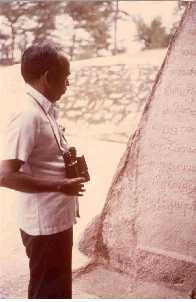

Home | Biodata | Biography | Photo Gallery | Publications | Tributes
Archaeology

 |

Home | Biodata | Biography | Photo Gallery | Publications | Tributes Archaeology |
 |
Thirukkalukkunram is known for its picturesque hilltop shrine Vedagirisvara, but there is also an important temple complex, the Bhaktavatsala, at the foot of the hill. An inscription on the prakara wall of this temple says that in the ninth year of Jatavarman Sundara Pandya, around 1260, the present main shrine of the Bhaktavatsala was built.

| The Bhaktavatsala has for its strong room, a structure which is even more ancient than its main shrine. This room is, in fact, the garbhagriha of a ninth century apsidal temple. The upper storey of this ancient temple is now missing, and the garbhagriha has evidently been repaired and given a flat roof in more modern times. |
| Just under its cornice, however, remains an original feature: a delightful row of small, sculptured figures, impish and pot-bellied, called bhutaganas. | |
On a recent trip, we found amidst all the frolicking ganas, a clear portrayal of saint Kannappan who is here also one of the ganas. This ardent devotee of Siva is shown kneeling next to a linga ready to gouge out his right eye with an arrow held in his right hand.
Among the earliest references to the Kannappan theme are brief passages in the seventh century hymns of Appar and Sambandar. The basic point being made in this Kannappan story is that the intense devotion of the rough hunter, Kannappan, was as pleasing to Siva as was the more refined worship of the orthodox priests. Brief references in Sankara's "Sivanandalahari" and Sundara's "Tiruttonduttogai", in the eighth and ninth centuries, led up to the more detailed twelfth century account of Sekkizhar's in the "Periya Puranam."
It will be evident, then, that the ninth century sculptural representation of Kannappan which we have noticed at Tirukkalukkunram takes one back more than a thousand years, and is very close to the period of the earliest literary references to Kannappan. Heretofore, the earliest known sculptural representations of Kannappan have been bronze images assigned to the eleventh century.
The relevant figures in the Tirukkalukkunram panel, from left to right, are as follows: First comes a hunter, who may also be Kannappan, shouldering a pole with two pigs suspended by the hind legs, one at each side of the pole. Next is a hunting dog, with its head turned towards the pigs. Then we see Kannappan kneeling next to the Sivalinga, ready to gouge out his right eye with an arrow (the bow is portrayed just below the arrow, and above the dog's head). A hand can be seen projecting out of the linga, indicating to Kannappan that he should desist from his extreme act of sacrifice. On the other side of the linga (also gana-like) are two figures representing the orthodox priest, shouldering a basket of ritual flowers, and holding lotuses in the left hand.